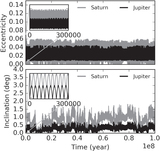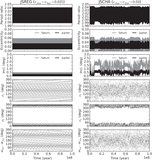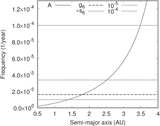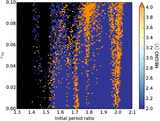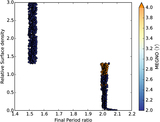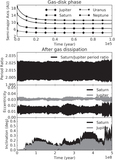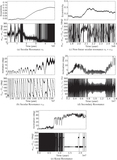Image Details
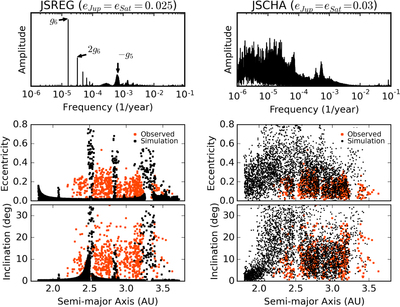
Caption: Figure 4.
Fourier analysis and excitation of the asteroid belt by the gas giants in two N-body simulations. In both cases, Jupiter and Saturn are locked in 2:1 MMR, with starting semimajor axes of 5.25 au and ∼8.33 au. In the JSREG simulation (left panels) the gas giants’ initial eccentricities are 0.025 and their orbits exhibit regular motion. In the JSCHA simulation (right) the giants’ initial eccentricities are 0.03 and their orbits are chaotic. Their mutual orbital inclination is initially 0.°5. Each system was integrated for 136 Myr, and to perform the Fourier analysis we used an output time step of 2 years; the top panels show the power spectra for ﹩{\varpi }_{\mathrm{Sat}}﹩ for each case. The middle and bottom panels show the dynamical excitation of the main belt in the two simulations, using a snapshot at 40 Myr. Some asteroids in the JSCHA simulation have larger eccentricities and inclinations than those observed. This does not mean that our results are inconsistent with the present-day asteroid belt. Highly eccentric and inclined objects are removed from the system during the later evolution of the solar system: during the dynamical instability between the giant planets (Morbidelli et al. 2010) and over the subsequent 3.8 billion years (Minton & Malhotra 2010). These simulations also do not take into account the gravitational influence of the growing terrestrial planets, which may remove a large fraction of dynamically overexcited asteroids. In the JSCHA simulation, asteroids with low orbital inclination are also observed between 1.8 and 2 au. Equally, these objects do not exist in the real belt today. It is highly likely that these objects will also be removed from this region during the accretion of the terrestrial planets and by the effects of SRs when Jupiter and Saturn reach their current orbits (e.g., ﹩{\nu }_{16}﹩ is at ∼1.9 au today; Froeschle & Scholl 1989).
Copyright and Terms & Conditions
© 2016. The American Astronomical Society. All rights reserved.


